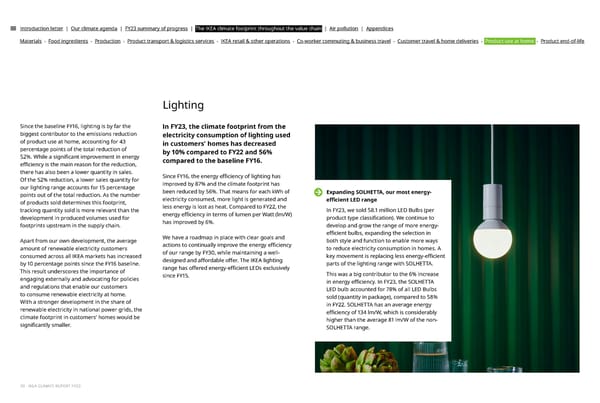Introduction letter | Our climate agenda | FY23 summary of progress | The IKEA climate footprint throughout the value chain | Air pollution | Appendices Materials - Food ingredients - Production - Product transport & logistics services - IKEA retail & other operations - Co-worker commuting & business travel - Customer travel & home deliveries - Product use at home - Product end-of-life Lighting Since the baseline FY16, lighting is by far the In FY23, the climate footprint from the biggest contributor to the emissions reduction electricity consumption of lighting used of product use at home, accounting for 43 in customers' homes has decreased percentage points of the total reduction of by 10% compared to FY22 and 56% 52%. While a signi昀椀cant improvement in energy compared to the baseline FY16. e昀케ciency is the main reason for the reduction, there has also been a lower quantity in sales. Of the 52% reduction, a lower sales quantity for Since FY16, the energy e昀케ciency of lighting has our lighting range accounts for 15 percentage improved by 87% and the climate footprint has points out of the total reduction. As the number been reduced by 56%. That means for each kWh of Expanding SOLHETTA, our most energy- electricity consumed, more light is generated and of products sold determines this footprint, e昀케cient LED range less energy is lost as heat. Compared to FY22, the tracking quantity sold is more relevant than the In FY23, we sold 58.1 million LED Bulbs (per energy e昀케ciency in terms of lumen per Watt (lm/W) development in produced volumes used for has improved by 6%. product type classi昀椀cation). We continue to footprints upstream in the supply chain. develop and grow the range of more energy- We have a roadmap in place with clear goals and e昀케cient bulbs, expanding the selection in Apart from our own development, the average both style and function to enable more ways amount of renewable electricity customers actions to continually improve the energy e昀케ciency to reduce electricity consumption in homes. A of our range by FY30, while maintaining a well- consumed across all IKEA markets has increased key movement is replacing less energy-e昀케cient by 10 percentage points since the FY16 baseline. designed and a昀昀ordable o昀昀er. The IKEA lighting parts of the lighting range with SOLHETTA. This result underscores the importance of range has o昀昀ered energy-e昀케cient LEDs exclusively engaging externally and advocating for policies since FY15. This was a big contributor to the 6% increase and regulations that enable our customers in energy e昀케ciency. In FY23, the SOLHETTA to consume renewable electricity at home. LED bulb accounted for 78% of all LED Bulbs With a stronger development in the share of sold (quantity in package), compared to 58% renewable electricity in national power grids, the in FY22. SOLHETTA has an average energy climate footprint in customers’ homes would be e昀케ciency of 134 lm/W, which is considerably higher than the average 81 lm/W of the non- signi昀椀cantly smaller. SOLHETTA range. 30 - IKEA CLIMATE REPORT FY23
 IKEA CLIMATE Report FY23 Page 29 Page 31
IKEA CLIMATE Report FY23 Page 29 Page 31